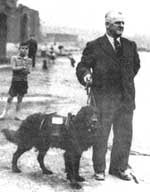There is a video report here (as of right now, 24th October). Unfortunately it doesn't seem to be possible to link direct to the video or show it here and I don't know how long it will be on that page.
Whizz isn't the first Swansea dog to make a name for himself rescuing people. Back in the 1930s Swansea Jack made a name for himself as a hero.
 Jack was a black, flat-coated retriever who lived with his owner William Thomas on land bordering the docks.
Jack was a black, flat-coated retriever who lived with his owner William Thomas on land bordering the docks. In 1931 the recovery of a twelve year old boy who had slipped off the edge of the docks was his first ‘proper’ rescue but it was the second rescue, that of a swimmer in difficulties between two piers, that brought Jack his first taste of fame. The event was reported in the local newspaper and the council organised a collection and rewarded Jack with a silver collar.
Following another rescue a few months later, Jack was made an honorary member of the national Tail Waggers Club, whose motto was ‘I help my pals’. The Tail Waggers featured Jack in their magazine and he received a silver medallion ‘For Bravery’.
Over the next few years Swansea Jack saved many more people from drowning including sailors, fishermen and swimmers. Many of these were reported in the local and national press and Jack’s fame spread.
Jack’s uncanny ability to spot trouble wasn't restricted to humans: a cocker spaniel stuck in the mud had reason to be grateful to Jack as did a sackful of unwanted puppies who survived thanks to Jack and the care his master gave them.
By September 1935, Jack’s total for human rescues was twenty one and he was invited to a special ceremony at Swansea Guildhall where he was presented with a shield from the PDSA and a bronze medal from the National Canine Defence League.
In November of the same year, Jack took part in an exhibition of ‘Brave Dogs’ organised by the Daily Mirror. He was one of very few dogs to receive the Daily Mirror collar for bravery and was included on the Daily Mirror Roll of Honour.
In September 1936 when he was chosen by the national newspaper to be ‘The Star Bravest Dog of the Year’ but just one year after this triumph, and aged seven, Swansea Jack became ill and died, seemingly as a result of eating rat poison.
When he died, Swansea Jack had been credited with twenty seven rescues. It’s true that there is no evidence to support some of these, but a large number were verified by witnesses or by the rescued person.
William Thomas buried Jack in a quiet spot at the end of his garden but three weeks after his death, due to public demand, Jack was buried again on the seafront. A fund to pay for a memorial stone was started and money came in from all over the world. One year later, in a service attended by the Mayor and other local dignitaries, the memorial was unveiled.

In 2000, Swansea Jack was named 'Dog of the Century' by NewFound Friends of Bristol who train domestic dogs in aquatic rescue techniques.
7 comments:
See - flat coat retriever, like a golden one but with flat, long, silky fur. Bit like a Holly-Harvey cross!
http://www.healthgene.com/canine/images/retriever_flat_coated.jpg
Handsome boy!
/retriever_flat_coated.jpg
I really enjoyed reading that :0)
I love newfoundlands we have a bullmastif atm (she's lovley of course)
Great story, Liz. Eurodog would enjoy that.
What a hero! I'd never heard about this before.
Well, one more thing for me to see when I come over there. :D
Post a Comment